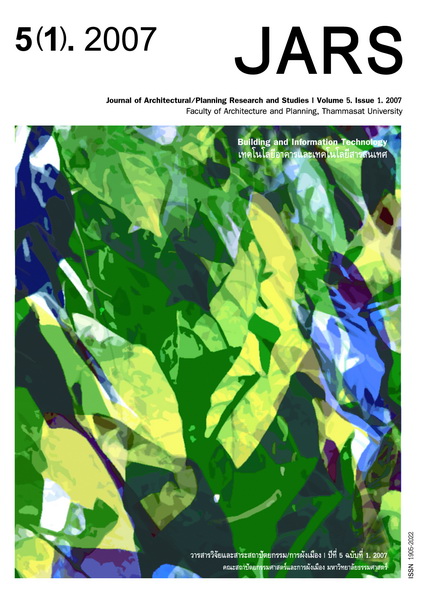Natural Ventilation in Atrium for Comfort
Main Article Content
Abstract
This research investigates the natural ventilation of an occupied glass atrium subjected to solar
radiation. The solar gain through a glass wall of the atrium serves as uniform vertical heating the occupants
and equipment distributed across the floor of the atrium serves as uniform horizontal heating. The atrium
vents to the exterior through two openings, one at the top and one at the base. Laboratory experiments
reveal that these conditions lead to vertical thermal stratification within the space. The atrium is warmer
than the outside air, with the lowest interior temperature at the floor level. A mathematical model is
developed to describe the inter-relationship between the vertical and horizontal heating and the consequential
thermal stratification and ventilation rate. Theoretical analysis shows that to achieve ventilation and thermal
comfort within the space, the amount of solar gain should be controlled in relation to the sizes and heights
of the vents. These findings are then applied to explore the control strategies for atria in range of climates.
Downloads
Article Details

This work is licensed under a Creative Commons Attribution-NonCommercial-NoDerivatives 4.0 International License.
All material is licensed under the terms of the Creative Commons Attribution 4.0 International (CC-BY-NC-ND 4.0) License, unless otherwise stated. As such, authors are free to share, copy, and redistribute the material in any medium or format. The authors must give appropriate credit, provide a link to the license, and indicate if changes were made. The authors may do so in any reasonable manner, but not in any way that suggests the licensor endorses you or your use. The authors may not use the material for commercial purposes. If the authors remix, transform, or build upon the material, they may not distribute the modified material, unless permission is obtained from JARS. Final, accepted versions of the paper may be posted on third party repositories, provided appropriate acknowledgement to the original source is clearly noted.
References
Tanabe, S., & Kimura, K. (1989). Importance of air movement for thermal comfort under hot and humid conditions. Proceedings of ASHRAE Far East Conference on Air Conditioning in Hot Climates, 95-103.
ไพบูลย์ รักษาสุทธิพันธ์. (2537). การศึกษาผลของชั้นความร้อนในโถงที่มีความสูงโดยใช้หุ่นจำลอง. วิทยานิพนธ์มหาบัณฑิต จุ ฬาลงกรณ์มหาวิทยาลัย.
ธนิต จินดาวณิค. (2540). สถาปัตยกรรมและเทคโนโลยี. กรุงเทพฯ: สำนักพิมพ์แห่งจุฬาลงกรณ์มหาวิทยาลัย.
Cooper, P., & Hunt, G. (1999). Ventilation and stratification in naturally ventilated spaces driven by heated internal vertical surfaces. Proceedings of HybVent Forum 1999.
Chenvidyakarn, T., & Woods, A. W. (2004). The control of pre-cooled natural ventilation. Building Service Engineering Research & Technology, 25(2), 127-40.
Chenvidyakarn, T. (2005). The impact of pre-cooling on multiple steady states in stack ventilation. Journal of Architectural/Planning Research and Studies, 3, 3-20.
Yuguo, L. (2001). Integrating thermal stratification in natural and hybrid ventilation analysis. Department of mechanical engineering. The University of Hong Kong, Hong Kong SAR.
CIBSE. (1988). CIBSE guide, vol. B: Installation and equipment data. St. Albans, UK: Staples Printers.

